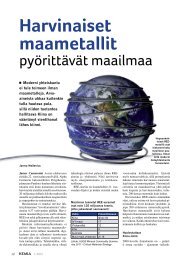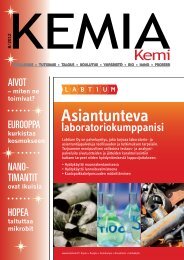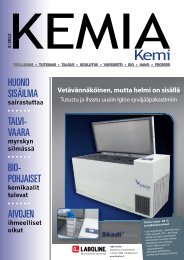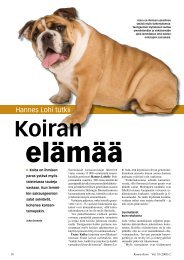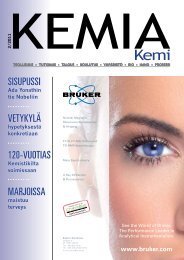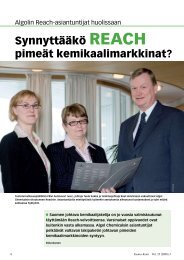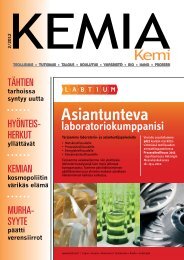in the Finnish chemical industry - Kemia-lehti
in the Finnish chemical industry - Kemia-lehti
in the Finnish chemical industry - Kemia-lehti
Create successful ePaper yourself
Turn your PDF publications into a flip-book with our unique Google optimized e-Paper software.
Bio-related technicalcommittees with<strong>in</strong> <strong>the</strong>responsibility of Kemesta• CEN/TC 233 Biotechnology• CEN/TC 335 Solid biofuels• CEN/TC 383 Susta<strong>in</strong>ably producedbiomass for energyapplications (withF<strong>in</strong>nish PetroleumFederation)• CEN/TC 411 Bio-based products• ISO/TC 238 Solid biofuels• ISO/TC 248 Project committee—Susta<strong>in</strong>ablity criteriafor bioenergy (withF<strong>in</strong>nish PetroleumFederation)• ISO/TC 255 Biogas• ISO/TC 266 Biomimetics• ISO/TC 276 BiotechnologyO<strong>the</strong>r standardisationareas of Kemesta• Transportable gas cyl<strong>in</strong>ders• Assessment of workplace air• Pa<strong>in</strong>ts, varnishes, pigments,dyestuffs, extenders• Pulp, paper, and board• Adhesives• Furniture• Explosives and fireworks• Plastics• Fertilisers and soil conditioners• Surface active agents• Photocatalysis• Cosmetics• Health risk assessment of <strong>chemical</strong>s• ChemistryOld partnersFor decades <strong>the</strong> forest <strong>in</strong>dustries havebeen an essential basis for <strong>the</strong> F<strong>in</strong>nisheconomy and welfare. Today’s ref<strong>in</strong>edproducts made from wood havegone through a high-tech productionprocess to meet <strong>the</strong> requirements ofdemand<strong>in</strong>g end-users.In <strong>the</strong> production processes,dozens of different bulk <strong>chemical</strong>s,performance <strong>chemical</strong>s, and f<strong>in</strong>e<strong>chemical</strong>s are needed. This meansthat <strong>the</strong> <strong>chemical</strong> <strong>in</strong>dustry is anLife withoutstandardswould bechaosThe benefits of standardsand standardisation have beenrecognised by several studies <strong>in</strong>different countries. An outcome isthat standards <strong>in</strong>crease <strong>the</strong> GDPby about 0.8 to one per cent.In everyday life <strong>the</strong> application ofstandards is not often noticed, but itwould be an impossible situation if goodsand th<strong>in</strong>gs did not fit toge<strong>the</strong>r and werenot <strong>in</strong>terchangeable.This is noticeable by anyone travell<strong>in</strong>gto <strong>the</strong> USA or Great Brita<strong>in</strong> if <strong>the</strong>y neglectto pack an adapter for <strong>the</strong> electricityoutlet. It would also be very cumbersomeif <strong>the</strong> office papers were not of <strong>the</strong> correctsize for <strong>the</strong> fil<strong>in</strong>g folder.The areas represented by Kemesta aresuch that a lot of test<strong>in</strong>g is needed bothwhen controll<strong>in</strong>g raw materials, phasesof production processes, and propertiesof end products. When test<strong>in</strong>g is alwaysdone us<strong>in</strong>g <strong>the</strong> same standardisedmethod, <strong>the</strong> results are comparable wi<strong>the</strong>ach o<strong>the</strong>r. In cases of product compla<strong>in</strong>tsimportant raw material supplier to <strong>the</strong>forest <strong>in</strong>dustries.On <strong>the</strong> o<strong>the</strong>r hand, <strong>the</strong> same is true<strong>the</strong> o<strong>the</strong>r way round: a remarkablenumber of <strong>chemical</strong>s are producedfrom wood and <strong>the</strong> by-products offorest <strong>in</strong>dustry processes, such asvarious acrylates, alcohols, esters,and carbonates. Such <strong>chemical</strong>sare used as raw materials for anenormous number of products used<strong>in</strong> all walks of life.it is important to have a proven andgenerally recognised method for test<strong>in</strong>g<strong>the</strong> product <strong>in</strong> question.Market surveillance is an area wherestandards are of essential importance.An example is <strong>the</strong> European <strong>chemical</strong>sregulation, Reach, based on whichsubstances are prohibited or <strong>the</strong>concentration of which is limited <strong>in</strong>articles. The concentration limits aregiven <strong>in</strong> <strong>the</strong> legislation, but controll<strong>in</strong>g<strong>the</strong> products <strong>in</strong> <strong>the</strong> market—<strong>in</strong>clud<strong>in</strong>gimported ones—would not be possiblewithout standardised test<strong>in</strong>g methods.Harmonised standardsIn Europe, a number of standardsare developed on request of <strong>the</strong> EUCommission, which gives CEN mandatesto develop harmonised standards onspecified topics.The work is usually done <strong>in</strong> English,but <strong>the</strong> titles of harmonised standardshave to be translated <strong>in</strong>to nationallanguages. The standardisation of biobasedproducts, for <strong>in</strong>stance, is done on<strong>the</strong> basis of two EU mandates.There is a reason for us<strong>in</strong>g standards asa tool <strong>in</strong> legislation. Requirements can bepresented <strong>in</strong> legislation. Specifications,classifications, and test<strong>in</strong>g methodsare, however, more easily presented <strong>in</strong>standards, <strong>the</strong>reby keep<strong>in</strong>g <strong>the</strong> legislativetexts shorter. Standards are also regularlyrenewed.58 KEMIA 5/2013



